Rhodonite: what is it, who suits, properties and meaning
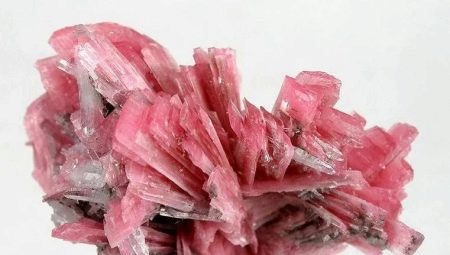
It is not for nothing that the Urals are called “the mountain of gems”. This place is indeed a deposit of many unique minerals. One of these stones is rhodonite.
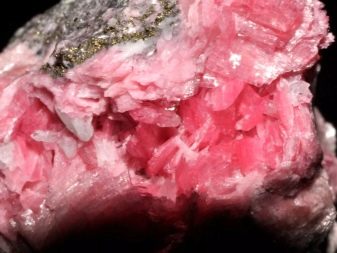
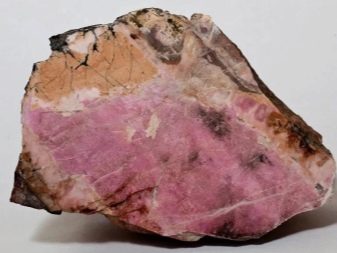
What it is?
Rhodonite is a semi-precious ornamental stone, the color of which can vary from rich shades of red and crimson to a dull, as if slightly dusty pink with various inclusions. The pattern of each stone is unique - it does not shine through in the sun, except for especially thin plates and a rare translucent variety.
The popular name of this stone is eagle, since long before the discovery of deposits in the Urals, local residents often found an unusual red mineral in eagle's nests. Therefore, it is still believed that an amulet made of a red stone, suspended over a baby cradle or crib, will help a child grow up as strong, proud and vigilant as a real eagle.
In fact, eagle is the most common name for the mineral in common parlance, but there are also names such as pink spar, faulerite, ruby spar and others related to the characteristics of its color range. One of the most poetic is the Dawn Stone. The mineral received this name for the similarity of its color with the first rays of the rising sun.
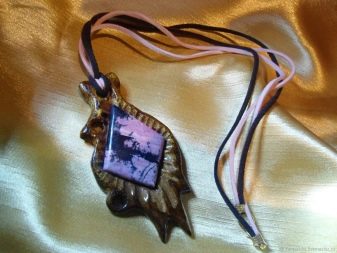

The main characteristic of rhodonite includes a description of the following properties:
- fairly high hardness, equal to about 5.5 on the Mohs scale;
- uneven fractures of the edges;
- opaque (translucent only in specific cases);
- glass luster;
- color - all shades of pink to rare crimson;
- the color of each stone is unique.
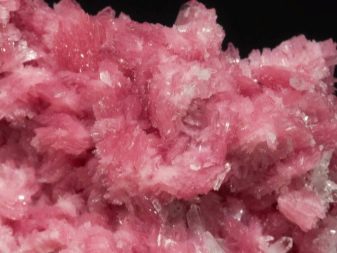
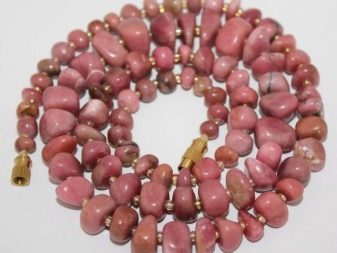
Place of Birth
Despite the fact that the first samples of this mineral were found in Germany, which was the official discovery and recognition of this type of semi-precious stone, it was known long before the German Christoph Friedrich Jasche even introduced the concept of "rhodonite" into everyday life. In Russia, in the Urals, this stone was known for a very long time, however, under a slightly different name. Thus, rhodonite has been mined in Russia a little longer than in the rest of the world.
The first samples of rhodonite were found even before the beginning of the twentieth century in the Yekaterinburg region, in the village of Maloye Sedelnikovo (not far from the village of Bolshoye Sedelnikovo in the Sverdlovsk region). It is not inferior to the minerals mined in this area, and the rhodonite vein in the village of Gagarskoe (its other names: Cheremshanskoe, Bazhenovskoe and Pushkarikhinskoe). Here rhodonite is located in the form of small nests and disseminations in the rock of quartz.
For a very long time it was believed that this is the only deposit of this mineral. However, to date, new deposits are being discovered throughout the Urals. Among them are Parnokskoe, Kurganovskoe and Tyshorskoe.



Over time, rhodonite began to be found not only in the Ural region, but in all regions of Russia. The most famous sources of this ornamental stone are the Trans-Baikal Territory, the Khabarovsk Territory, the Republic of Buryatia, the Republic of Sakha-Yakutia, the Primorsky and Krasnoyarsk Territories and Karachay-Cherkessia.
In addition to these remote regions of the Russian Federation, rhodonite is also mined in Tajikistan, Kazakhstan, and Uzbekistan. It is also known about the presence of deposits in East China, Japan and in some European countries, for example, in Sweden. The largest suppliers of rhodonite in the world are countries such as Canada, the United States of America, Australia, Brazil, Mexico, Indonesia and the islands of Madagascar and Tanzania.

Views
The division of rhodonite into varieties is arbitrary. As a rule, a stone is attributed to certain categories, they look first of all at the color of the stone (color, blotches, saturation) and at how transparent the specimen looks. The classification of varieties is constantly replenished with more and more new varieties discovered, which look so unusual that they cannot be attributed to any already existing category, so new ones have to be distinguished.
The most beautiful and rare, therefore, the most expensive is ruby-homogeneous rhodonite. It has a deep red color, which gives it some resemblance to the ruby, which is why the name of this variety appeared. It has a very pure color, without internal inclusions of other shades and other impurities. Jewelry is made from this subspecies, combining, like rubies, with gold and sometimes diamonds, although such rhodonite itself looks quite impressive.
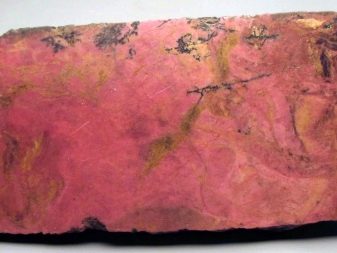
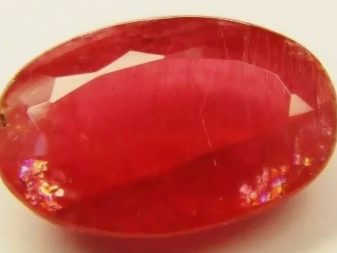
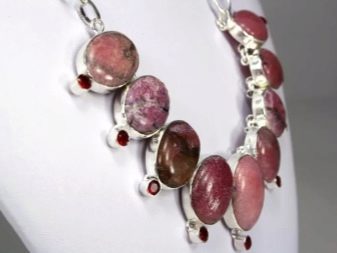
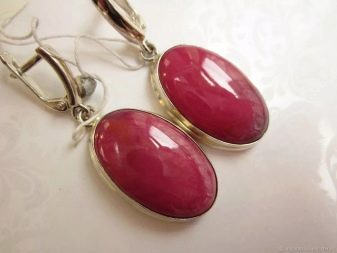
The next in cost, transparency and color purity is translucent rhodonite. In terms of the palette of shades, it belongs more to pink, although it may look pinkish or coral due to its translucency, which gives rise to an interesting play of colors.
Next on the list will be common pink rhodonite, also known as pink spar... Opaque, it can be of any shade of pink, almost uniform color without various impurities and inclusions. It is found quite often, which is why it has a low cost and is often used for crafts and interior design.
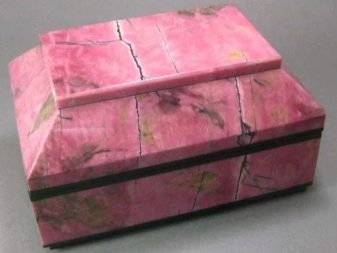
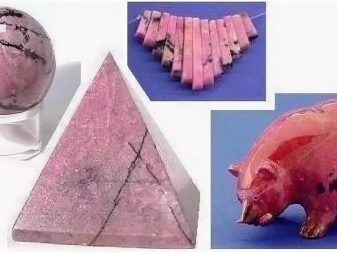
It is worth considering the following varieties with a heterogeneous color:
- fowlerite - this species contains a certain amount of zinc, which gives the mineral yellow or brownish blotches;
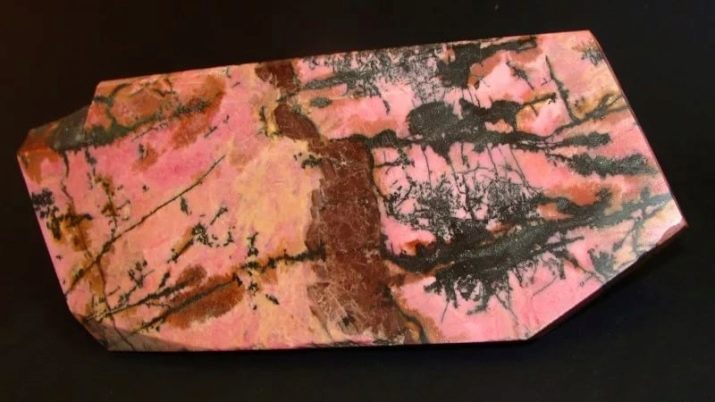
- tape - as the name implies, in specimens of this variety, stripes of two colors alternate, most often gray and pink, but sometimes brown is also present; sometimes the stripes can be of different tones of pink;
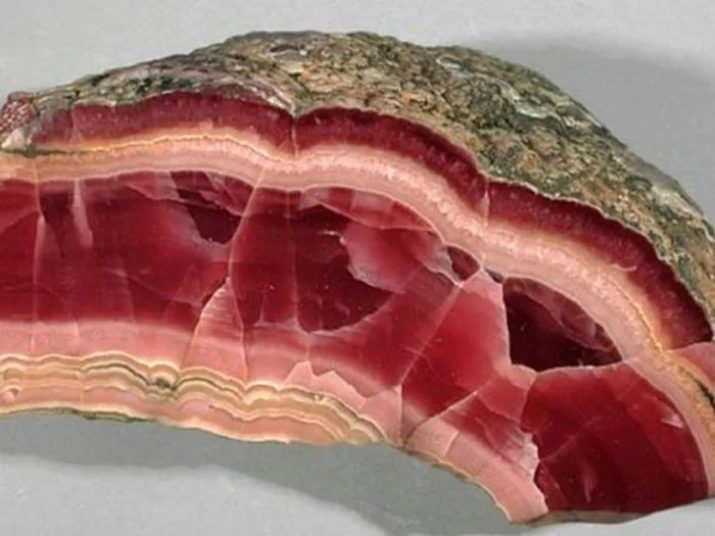
- spotted - one of the lowest rated; the reason for this is the presence of spots of different shapes and different colors (brown, dirty brown, gray, yellow, pink) on the surface;
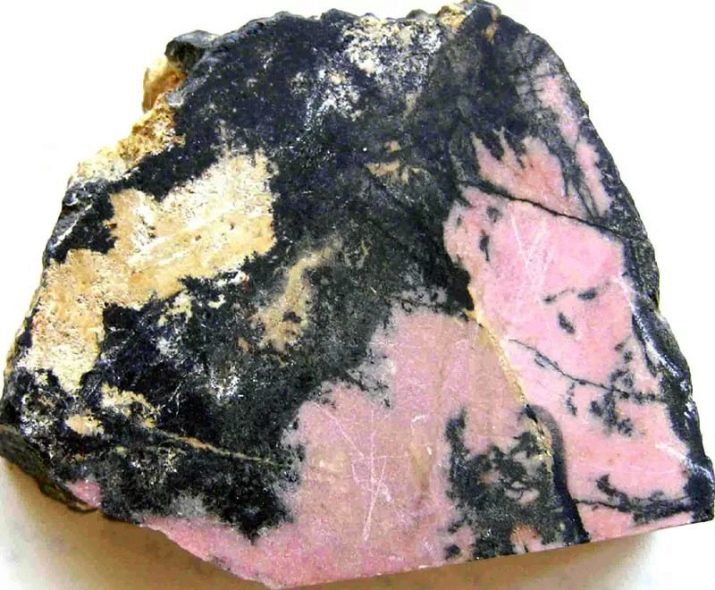
- mourning - received such a gloomy name due to the presence of a black pattern in the color, which occupies a significant area of the stone surface; in this regard, it is used for the manufacture of tombs, monuments, gravestones and so on;
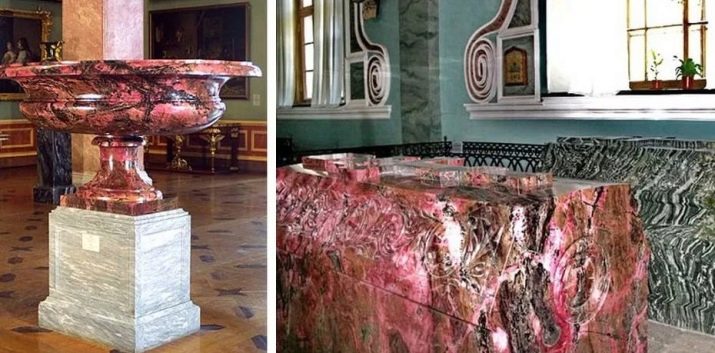
- dendritic - it consists of several colors: pink, brown and black in small quantities; in some specimens, you can see the remains of twigs, moss and other plant species, which are actually the result of chemical processes and are called manganese hydroxide.
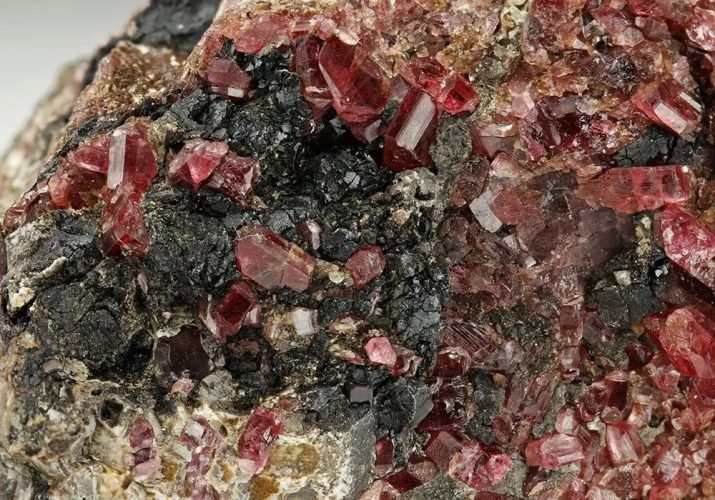
Important! Not long ago, cobalt rhodonite was discovered, which looks like a lavender, purple or lilac mineral, which makes it similar to amethyst and ametrine.
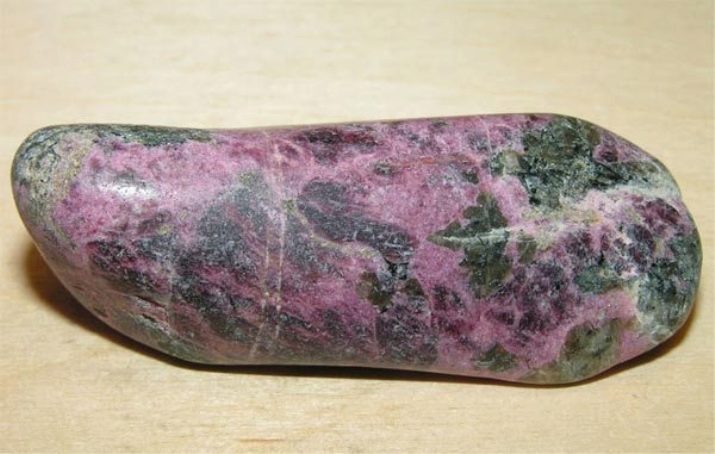
Properties
Rhodonite has been known in Russia for a very long time. It is not surprising that over time, many mystical and healing properties began to be attributed to these crystals, which, according to legend, sometimes surpassed the properties of an emerald.
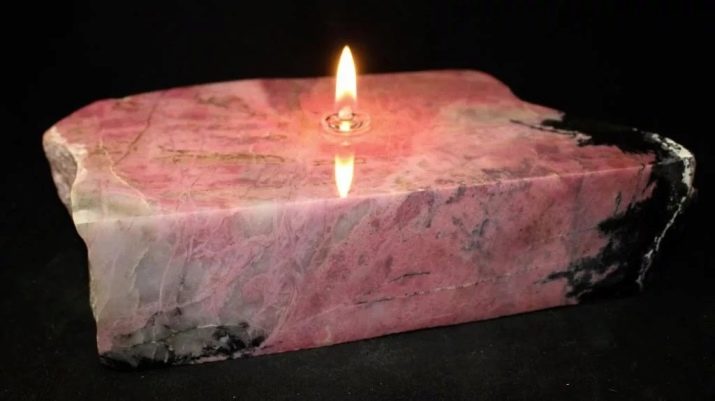
Physical and chemical
It is worth starting with the most common physical properties that any mineral has. The pink color of the stone is based on chained manganese silicate, which is also the chemical composition of this mineral. Hence, the more manganese is contained in the composition, the richer the pink color of the stone will be.
Rhodonite has a glassy luster, most often it is opaque. Transparent and translucent specimens are very rare in nature and are highly prized in the jewelry industry and collectors. When grinding, the surface of the stone acquires a mirror polish and the same cold shine. The hardness of the mineral ranges from 5 to 6.5 points on the Mohs scale.
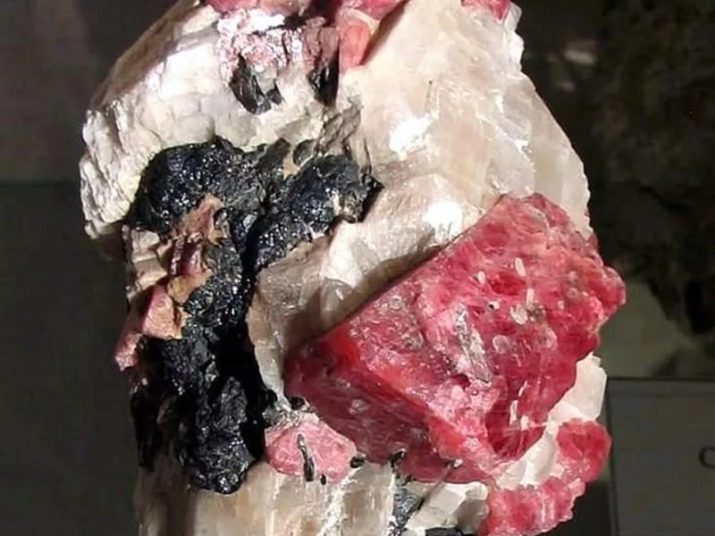
Healing
Rhodonite is considered mostly a mineral for women, as it promotes easy bearing and a favorable birth of a child, who is provided with good health in the first minutes of life. It promotes conception.
The stone is especially recommended for young women who become pregnant for the first time. Wearing rhodonite is an excellent prevention of some female diseases of the reproductive and genitourinary systems. Older women will help to preserve beauty and youth as long as possible, since the energy of the stone coincides with the female energy field.
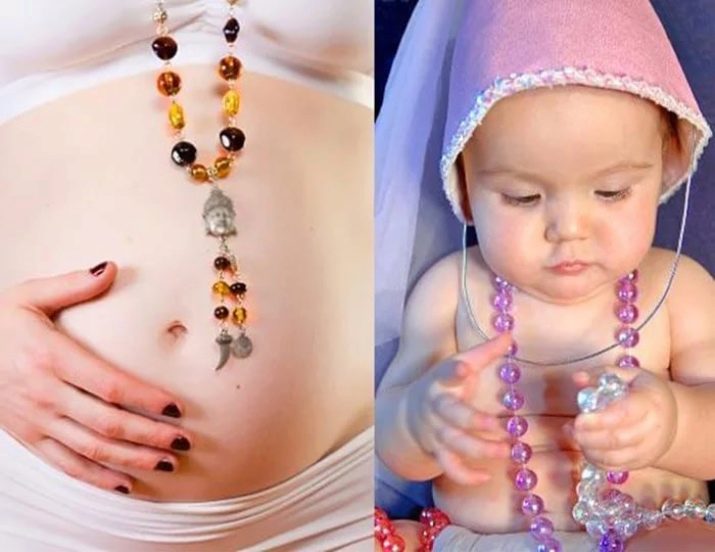
It can prevent the development of eye diseases by leaving small stones in front of your eyes for a few minutes every day. Such treatment will help relieve unnecessary stress from the eyes and normalize eye pressure, which is especially useful for those who work a lot at the computer or in another area where there is a lot of stress on vision.
For diseases of the endocrine system, a rhodonite necklace will help. The stone also helps with diseases of the circulatory and cardiovascular systems, heart and liver... Instead of a necklace, you can also use a rhodonite pendant, but on a short chain so that the mineral fits as close to the neck as possible. If your main task is the prevention of liver diseases (including the treatment of hepatitis), then you should use a rhodonite ring or a brooch on the right side of the body. The stone is able to even out the heart rate, normalize blood pressure and improve blood circulation.
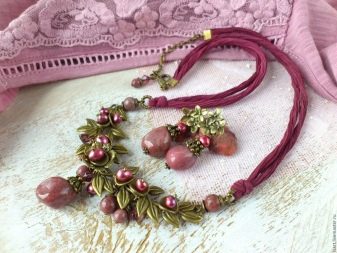
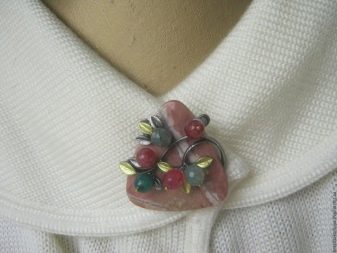
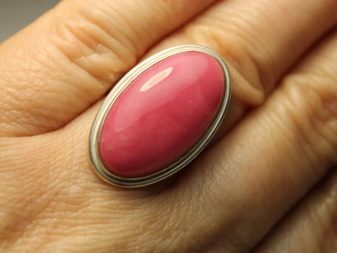
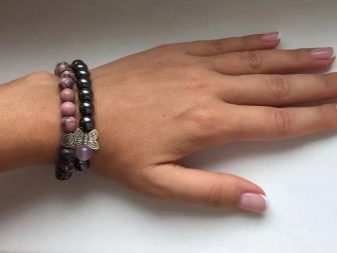
Another area of action of the stone, which for some reason is forgotten by lithotherapists, is the pancreas.... Rhodonite acts on enzymes, accelerating and facilitating the process of digesting food and assimilating nutrients, which allows the body to restore health and energy reserves much faster. And also wearing this mineral has a beneficial effect on disorders of the nervous systems, for example, with neuroses.
The stone makes a person stress-resistant, helps to avoid nervous breakdowns, bouts of irritability, helps to improve sleep, cure insomnia and restore memory. It will calm you in case of panic attacks, fears and nightmares, it will give you optimism, hope and a state of harmony. Healing rhodonite balls are very popular, used for massage and meditation.
Remember, the color of the stone is very important. If you are going to use this mineral for the treatment or prevention of a disease, then you should choose an instance where there are as few black or gray inclusions and impurities as possible, ideally there are none at all.

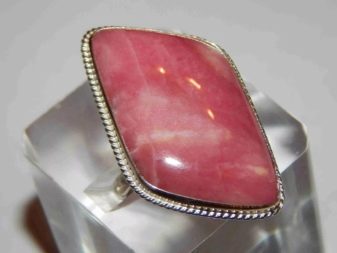
Magical
First of all, rhodonite is known in magic as an ornamental stone for many esoteric instruments that can serve as talismans for a very long time. Products made from this mineral are like a battery that can be charged with both bad emotions of its owner and good ones. If you purchase a rhodonite product as a spare battery, take care not to inadvertently saturate it with negative emotions.
Rhodonite is a stone of creative people. It will help to discover the abilities and talents hidden so far, to step over laziness and ultimately lead to well-deserved success and fame. In a creative crisis, the eagle brings inspiration and self-confidence, reduces the fear of failure and new beginnings.
To increase self-confidence and leadership qualities, a product made of a mineral should be worn on the left hand.

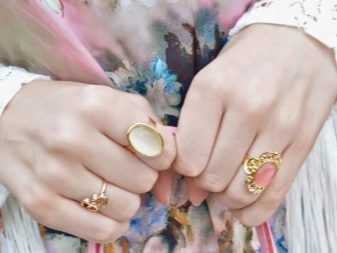
Rhodonite crafts are also used as a family amulet. This is a good gift for any family holiday - a product made of this mineral will protect you and your loved ones from envy, gossip, betrayal, quarrels and other people's insidious intrigues for a long time. If you are still lonely, then rhodonite will attract your soul mate and kindred spirit to you. The stone is able to enhance intuition and bring good luck, which makes it indispensable for gamblers.
Eagle has a rare ability increase the material wealth of the ownerso it comes as no surprise that many collectors are eager to get it in their collection. If you place rhodonite with dark spots in the hallway or corridor, you will be protected from intruders. If necessary, you need to conduct a meditation that will fill the stone with your positive energy and will strengthen the owner by strengthening its meaning for a person.
The best way to unleash the potential of jewelry or any other rhodonite product will help a frame made of copper or silver. Remember that the energy of a stone, like its properties, is highly dependent on its color.
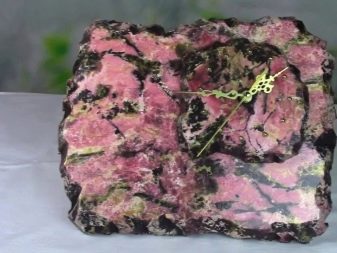
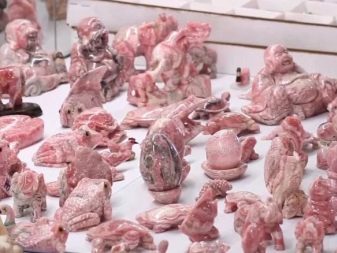
Who is it suitable for?
In terms of its energy, rhodonite is quite delicate and will not do any harm, so they can wear jewelry with it all signs of the zodiac.
But for the representatives of the fire element - Sagittarius, Aries and Leo - any product with an eagle will remain a simple piece of jewelry without any useful properties. With extreme caution, Sagittarius and Aries should treat the acquisition of ruby rhodonite - a perfectly clean stone without inclusions has enhanced qualities, which, multiplied by the swiftness and dynamism of these signs, can lead to absolutely unpredictable consequences.
Rhodonite is ideal for air signs, especially for Gemini and Libra. Gemini will be able to improve their already enormous mental abilities and intuition, they will receive a desire to explore more and more new horizons. A spotted variety of rhodonite works best for them.



Libra will increase self-esteem, self-confidence. If Libra lacks a state of inner peace, then you need to purchase pink rhodonite, and if the desire to increase your popularity with the opposite sex prevails, then the most valuable ruby rhodonite is suitable for this.
This stone is not contraindicated, but it can lead the earth signs - Virgo, Capricorn and Scorpio into deep despondency. If the frantic energy of a scorpion is able to resist melancholy, then Virgo and Capricorn should wear rhodonite with caution and fickleness.
In any case, it is worth choosing an amulet stone for yourself, relying primarily on your own feelings and intuition, and only then can you make the right choice.




Compatibility with other stones
Rhodonite jewelry often involves the use of other stones and metals. It depends not only on the idea of the jeweler-creator, but also on the type of mineral. For example, if the classic combination for ruby rhodonite is gold and diamonds, which play up its rich bright color, then using spotted or mournful rhodonite in such a combination will simply destroy the entire impression of the jewelry.
Quite often, silver is used for jewelry with an eagle. This neutral-colored metal is capable of creating a simple yet elegant piece of jewelry with almost any kind of stone.
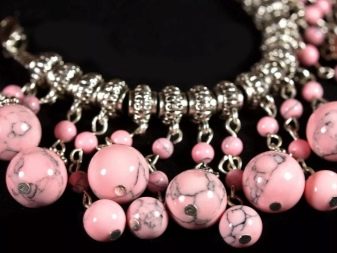
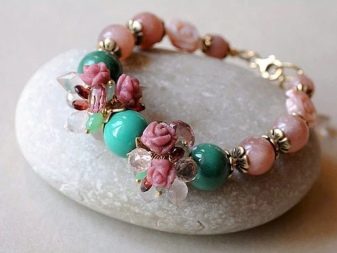
If you look at jewelry from an esoteric point of view, then with the help of other stones you can make combinations that affect different areas of life, namely:
- if you are a public person and the attention and perception of the public is important to you, then pay attention to the combination with sapphire or ruby, but choose one thing, not all at once;
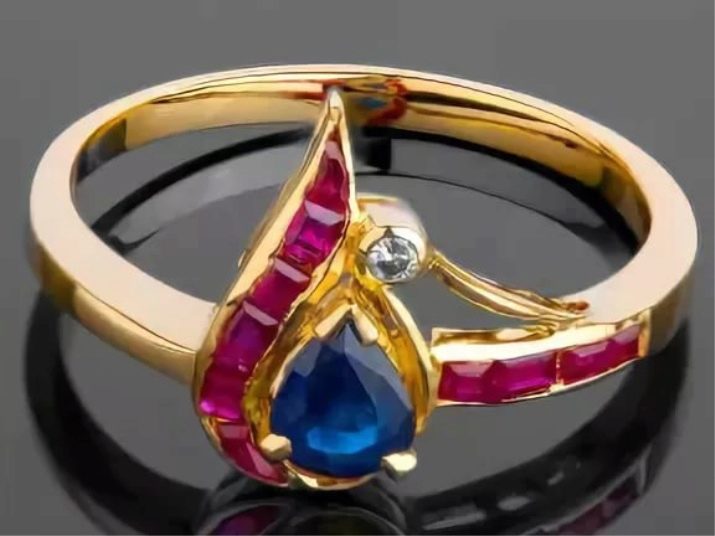
- for creative people who need recognition, it is worth choosing a piece of jewelry with rhodonite and tiger's eye;
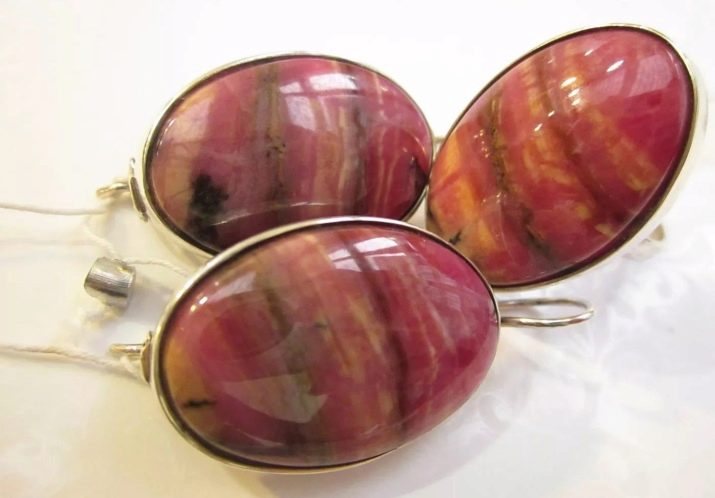
- a combination of a pink eagle with jade will serve to increase material wealth;
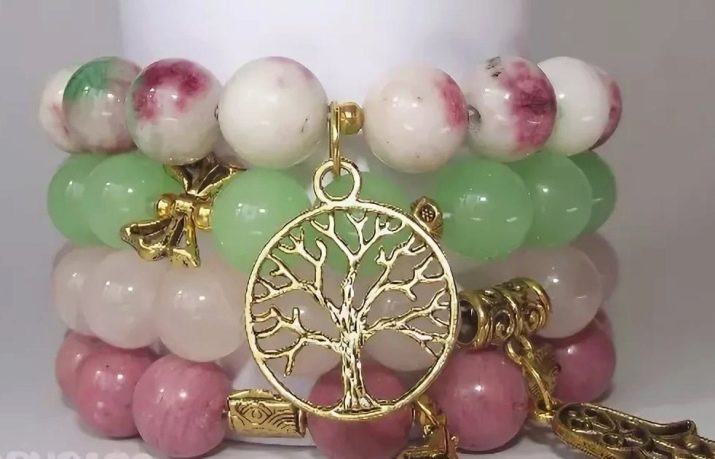
- to conclude a truce, refer to jewelry with rhodonite and turquoise;
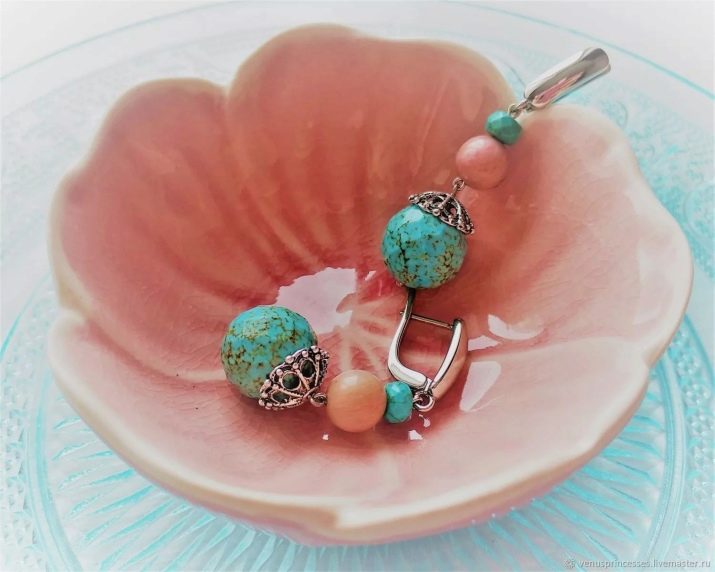
- often used a combination of pink spar and carnelian framed in silver to create a delicate, feminine look.
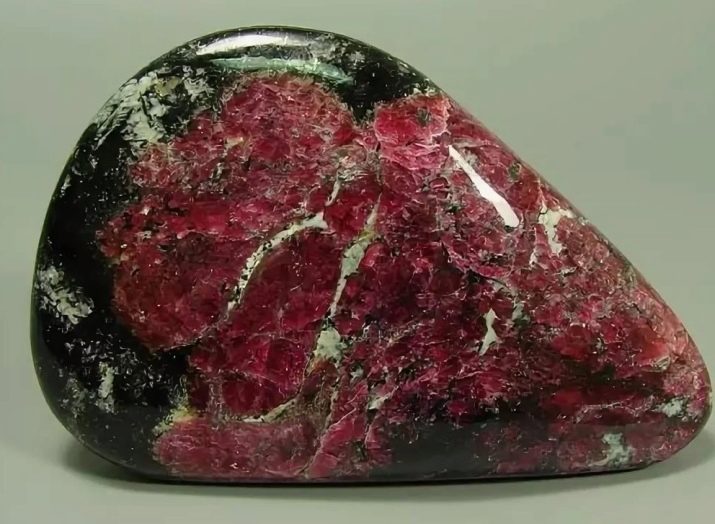
How to distinguish from a fake?
Not all varieties of rhodonite tend to be counterfeited. As a rule, most often on the market there is a plastic "ruby rhodonite" or "translucent", but made of a simple pink glass - purple. If you buy other varieties of eagle, then first of all pay attention to its color - in natural stone there will always be inclusions, patterns of a different color or other unique features.
You can compare the weight - a real stone is usually heavy, while plastic is much lighter. But if the fake is made of glass, then it will be much more difficult to identify it. A real mineral is quite dense and does not conduct heat well, therefore, hold the product in your hands for a few minutes - if it heats up quickly, then you have a fake.
Defects in the form of various damages should not be present on the surface of the stone. Real rhodonite is very hard, so damaging it is not an easy task.
But do not confuse external damage with the features of the formation of the rock, which can be seen through a magnifying glass. Each piece has its own unique pattern, which can take on the most bizarre shapes. The systematic pattern is a sign of a fake.

Care
Despite the fact that rhodonite is rather unpretentious, it is better not to break some rules for caring for it, then the stone will last much longer.
- The eagle is not suitable for constant wear. He needs to "rest" for a while, and before that wash it with warm running water and soapy water, then wipe it with a soft cloth. Do not use hard brushes or aggressive cleaning agents when cleaning.
- The stone should be protected from sudden temperature changes, falls and rough physical impact. Ideal for storing precious stones - a separate box or pouch for each.
- If some interior decorations or decorative souvenirs are made from the orlets, then it is enough to simply wipe them from dust. Often decorative items are made of pink spar, which is not very durable. In this regard, the products should be protected from shocks and falls.
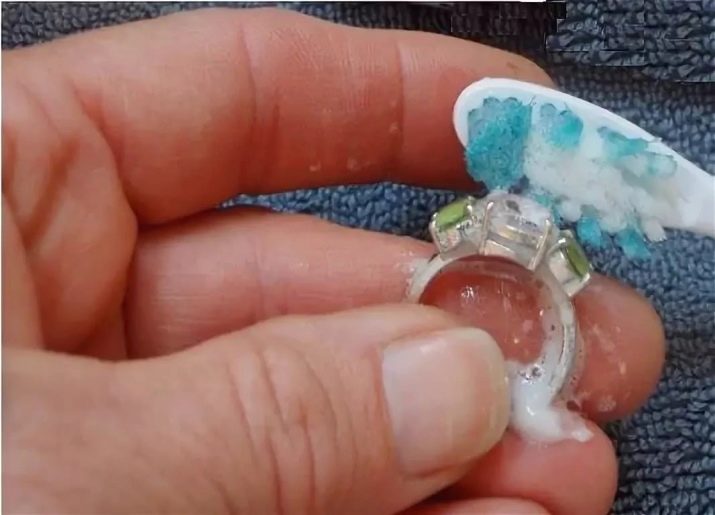
For the features of the stone, see the next video.








